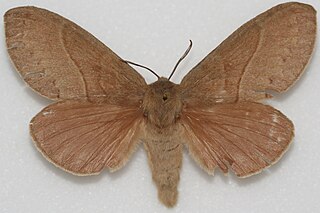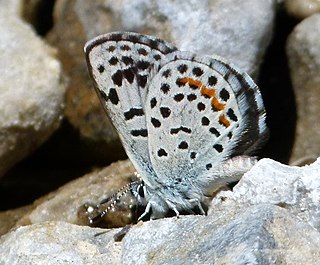Chlorobaptella is a monotypic moth genus of the family Crambidae erected by Eugene G. Munroe in 1995. Its only species, Chlorobaptella rufistrigalis, was first described by William Barnes and James Halliday McDunnough in 1914. It is found in North America, where it has been recorded from California and Nevada. Moths in this genus are distinguished from moths in similar genera by their small palpi and obsolete tongues.
Chrismania is a monotypic moth genus of the family Crambidae. Its only species, Chrismania pictipennalis, is found in North America, where it has been recorded from southern California and Arizona. Both the genus and species were first described by William Barnes and James Halliday McDunnough in 1914.
Dichozoma is a monotypic moth genus of the family Crambidae erected by Eugene G. Munroe in 1961. Its only species, Dichozoma parvipicta, was first described by William Barnes and James Halliday McDunnough in 1918. It is found in North America, where it has been recorded from Arizona, California, Utah and Texas.

Cryphia is a genus of moths of the family Noctuidae. The genus was erected by Jacob Hübner in 1818.

Grotella is a genus of moths of the family Noctuidae first described by Leon F. Harvey in 1875.
Prochloridea is a genus of moths of the family Noctuidae erected by William Barnes and James Halliday McDunnough in 1911.

Dicogaster is a genus of moths in the family Lasiocampidae first described by William Barnes and James Halliday McDunnough in 1911. Its only species, Dicogaster coronada, was first described by Barnes in 1904. It is found in Arizona.
Hymenodria is a monotypic moth genus in the family Geometridae erected by James Halliday McDunnough in 1954. Its only species, Hymenodria mediodentata, was first described by William Barnes and McDunnough in 1911. It is found in North America.

Cryphia cuerva, the cryphia moth, is a moth of the family Noctuidae first described by William Barnes in 1907. It is found in western North America from British Columbia and Alberta, south to California.
Schinia carolinensis is a moth of the family Noctuidae first described by William Barnes and James Halliday McDunnough in 1911. It is found in the United States from eastern North Carolina to the Florida peninsula and probably along the Gulf Coast.
Idia parvulalis is a species of litter moth of the family Erebidae first described by William Barnes and James Halliday McDunnough in 1911. It is found in North America, including its type location, the Santa Catalina Mountains in south-eastern Arizona.
Bleptina sangamonia is a species of moth of the family Erebidae first described by William Barnes and James Halliday McDunnough in 1912. It is found in the US from Illinois and Maryland, south to at least South Carolina, but it is not present in Pennsylvania, New Jersey and Delaware.
Ursia is a genus of moths of the family Notodontidae, the prominents. The genus was erected by William Barnes and James Halliday McDunnough in 1911.
Acroncosa is a genus of snout moths in the subfamily Phycitinae. It was described by William Barnes and James Halliday McDunnough in 1917. The type species is Acroncosa albiflavella.
Anemosella viridalis is a species of snout moth in the genus Anemosella. It was described by William Barnes and James Halliday McDunnough in 1912, and is known from Mexico and the US state of Arizona.

Euphilotes ancilla, the Rocky Mountain dotted blue, is a species of butterfly of the family Lycaenidae. It is found from Washington south to California and southern Alberta and Saskatchewan south through the Rockies and high plains to Wyoming, Colorado, Utah, and northwestern New Mexico. The species was first described by William Barnes and James Halliday McDunnough in 1918.
Negalasa is a monotypic snout moth genus. Its one species, Negalasa fumalis, is found in the US state of Arizona. Both the genus and species were described by William Barnes and James Halliday McDunnough in 1913 in the same paper.
Agylla septentrionalis is a moth of the family Erebidae. It was described by William Barnes and James Halliday McDunnough in 1911. It is found in North America, including Arizona and South Carolina.
Comadia albistrigata is a moth in the family Cossidae first described by William Barnes and James Halliday McDunnough in 1918. It is found in North America, where it has been recorded from Arizona, New Mexico and Texas.
Cryphia flavidior is a species of moth in the family Noctuidae. It was first described by William Barnes and James Halliday McDunnough in 1911 and it is found in North America.
This page is based on this
Wikipedia article Text is available under the
CC BY-SA 4.0 license; additional terms may apply.
Images, videos and audio are available under their respective licenses.




